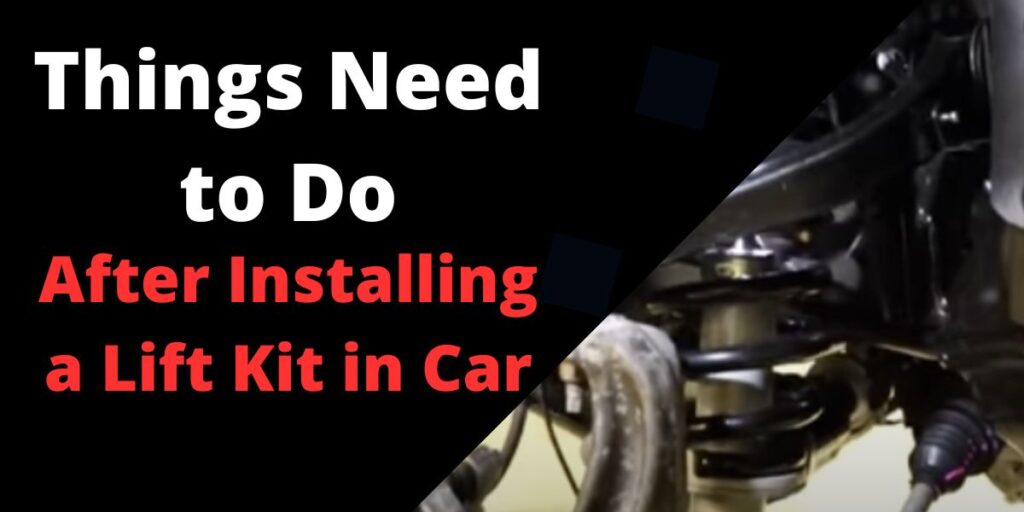When you install a lift kit on your vehicle, you unlock a world of off-road adventures and improved aesthetics. However, it’s essential to take certain actions to ensure safety, optimize performance, and make the most of your worthy lifted vehicle.

In this article, we’ll discuss ten crucial things you should do after installing a lift kit. Let’s dive in!
Table of Contents
1. Perform a Safety Check at the Very Beginning
A. Inspect and Tighten All Bolts and Connections
To ensure the safety and reliability of your lifted vehicle, it is crucial to inspect and tighten all bolts and connections after installing a lift kit. Over time, vibrations and off-road adventures can loosen bolts, potentially leading to instability or damage.
Using the appropriate tools, carefully check all suspension components, including control arms, sway bars, and shock absorbers. Tighten any loose bolts to the manufacturer’s recommended torque specifications, ensuring a secure and stable setup for your lifted vehicle.
B. Verify Proper Alignment and Suspension Settings
Installing a lift kit can alter your vehicle’s alignment and suspension settings. It is essential to verify that the alignment angles, such as toe, camber, and caster, are within the manufacturer’s specifications. Misaligned wheels can cause uneven tire wear, reduced handling, and potential steering issues.
Additionally, check the suspension settings to ensure they match the recommended height and specifications provided by the lift kit manufacturer. Proper alignment and suspension settings will optimize the vehicle’s performance, handling, and safety.
C. Check Tire Pressure and Condition
Lifted vehicles often require adjustments to tire pressure to maintain optimal performance and safety. Verify that your tires are inflated to the recommended pressure specified by the tire manufacturer. Improper tire pressure can affect traction, braking, and overall handling, particularly during off-road excursions.
Additionally, inspect the tire condition, including tread depth and any signs of damage or wear. Replacing worn or damaged tires is essential to ensure adequate grip and traction both on and off the road. Regularly monitoring tire pressure and condition will enhance the longevity and performance of your lifted vehicle.
Subscribe for News Updates
2. Adjust Your Driving Style According to Lift Kit
A. Changes in Vehicle Dynamics With a Lift Kit
Installing a lift kit alters the dynamics of your vehicle, requiring adjustments in your driving style. The increased ride height and ground clearance affect various aspects of vehicle performance, including stability, maneuverability, and center of gravity.
With a higher center of gravity, it is essential to approach turns and corners more cautiously to avoid potential rollovers. Understanding these changes will help you adapt your driving techniques to maximize the safety and performance of your lifted vehicle.
B. The Need for Adapting to Increased Height and Ground Clearance
With a lift kit, your vehicle gains increased height and ground clearance, allowing you to conquer challenging terrains and obstacles. However, it is crucial to be aware of the added height when navigating low clearance areas, such as parking garages or low-hanging branches.
Adjusting to the increased height ensures that you avoid potential collisions or damage to your vehicle. Developing an awareness of your vehicle’s dimensions and limitations will help you confidently maneuver through various driving conditions, both on and off the road.
Remember, proper safety checks, including inspecting and tightening bolts, verifying alignment and suspension settings, and checking tire pressure and condition, are essential to ensure a safe and reliable lifted vehicle.
Additionally, understanding the changes in vehicle dynamics and adapting your driving style accordingly will maximize the performance and enjoyment of your lifted vehicle.
Popular Articles of This Site:
- Are Lift Kits Bad for Atvs?
- Does a Lift Kit Add the Value of a Truck
- Crazy & Best Techniques to Lift a Car Without a Lift Kit
- Lift Kits: Cutting vs. No Cutting
3. Upgrade Your Tires Adjustment
A. Importance of Selecting Appropriate Tires for Off-roading
Choosing the right tires is crucial when it comes to off-roading with a lifted vehicle. Off-road tires are specifically designed to handle the demands of uneven terrains, provide superior traction, and resist punctures or damage.
Look for tires with aggressive tread patterns that offer excellent grip on various surfaces, including mud, sand, and rocks.
Additionally, consider the load rating of the tires to ensure they can support the weight of your lifted vehicle and any additional gear you may carry.
B. Explore Different Tire Options for Specific Terrains and Conditions
Different off-road terrains and weather conditions require specific tire characteristics. For muddy terrains, mud-terrain (M/T) tires with wide, deep lugs are ideal to provide optimal traction and self-cleaning capabilities. All-terrain (A/T) tires offer a versatile option, suitable for a range of terrains, including gravel, sand, and light mud.
If you often encounter rocky terrains, consider tires with reinforced sidewalls for added protection against punctures. Research and explore different tire options to find the best match for your off-road adventures.
C. Recommendations for Tire Size, Tread Pattern, and Durability
When choosing tires for your lifted vehicle, consider factors such as tire size, tread pattern, and durability. Larger tire sizes not only enhance ground clearance but also improve off-road performance by providing more traction and stability. Opt for tread patterns that suit your specific off-roading needs.
For example, aggressive, chunky tread patterns are better for mud and loose surfaces, while more tightly packed tread patterns offer better grip on hard-packed trails.
Additionally, prioritize durable tires that can withstand the rigors of off-roading, as they will be subjected to rocks, sharp objects, and challenging terrains.

4. Consider Reinforcing Suspension Components
A. Explain the Potential Stress on Suspension Parts Due to a Lift Kit
Installing a lift kit increases the stress on your vehicle’s suspension components. The additional height and changes in the suspension geometry can place greater demands on the control arms, sway bars, and other suspension parts.
This increased stress can lead to premature wear, reduced handling performance, and potential safety issues. Reinforcing these components is essential to ensure they can withstand the added forces and maintain proper functionality.
B. Reinforcement Options Like Upgraded Shocks, Sway Bars, and Control Arms
To strengthen your vehicle’s suspension, consider upgrading key components. High-quality shocks specifically designed for lifted vehicles offer improved damping and better control over rough terrains. Upgraded sway bars enhance stability and reduce body roll during cornering.
Additionally, stronger control arms with improved bushings and joints provide better articulation and durability. Consulting with suspension specialists or off-road enthusiasts can help you identify the best reinforcement options for your specific vehicle and driving needs.
Remember, upgrading your tires to suit off-roading conditions, including selecting appropriate tire types, exploring different tire options, and considering factors like tire size, tread pattern, and durability, is crucial for optimal performance.
Additionally, reinforcing suspension components to handle the increased stress caused by a lift kit will ensure a safer and more capable off-road experience.
5. Insure Your Vehicle Appropriately
Installing a lift kit may impact your vehicle’s insurance coverage. It’s crucial to discuss the changes with your insurance provider to ensure proper coverage. This will help protect you financially in case of any accidents or damages.
Don’t forget to update your policy and provide any necessary documentation to ensure you have the right level of protection.
6. Obtain Proper Lift Kit Installation Documentation
After installing a lift kit, make sure to keep the installation instructions and documentation. These documents are invaluable for troubleshooting and future modifications. In case you encounter any issues or plan to make further changes to your vehicle, having the correct documentation will save you time and effort.
7. Understand the Impact on Fuel Efficiency
It’s important to be aware that installing a lift kit can potentially affect your vehicle’s fuel efficiency. The increased weight, changes in aerodynamics, and larger tires can contribute to a slight decrease in fuel economy.
To mitigate this, practice fuel-efficient driving techniques such as smooth acceleration, maintaining proper tire pressure, and reducing unnecessary idling.
8. Engage in Professional Off-road Training
To fully enjoy the capabilities of your lifted vehicle, consider enrolling in professional off-road training courses or workshops. These programs provide valuable knowledge and hands-on experience in navigating challenging terrains, understanding vehicle limitations, and honing your off-road driving skills.
Professional training ensures your safety and helps you make the most of your lifted vehicle’s capabilities.
9. Monitor and Address Driveline Vibrations
A lift kit can potentially cause driveline vibrations, leading to an uncomfortable driving experience. Monitor your vehicle for any vibrations and address them promptly.
Proper alignment, balanced driveshafts, and using high-quality components can help minimize or eliminate vibrations, ensuring a smooth and enjoyable ride.
10. Assess the Need for Additional Modifications
Evaluate your driving needs and goals to determine if additional modifications are necessary.
Depending on your preferences and the level of off-roading you plan to undertake, consider potential modifications such as gear ratio changes, axle upgrades, or differential locks.
These modifications can further enhance your vehicle’s off-road capabilities and tailor it to your specific requirements.
Frequently Asked Questions

Q: What are the must-have things to do after installing a lift kit?
Answer: The essential things to do after installing a lift kit include performing a safety check, adjusting driving style, upgrading tires, installing off-road lighting, reinforcing suspension components, planning for regular maintenance, and exploring off-road accessories.
Q: How often should I perform a safety check after installing a lift kit?
Answer: It’s recommended to perform a safety check immediately after installation and periodically thereafter, such as every few months or before significant off-road trips.
Q: How do I choose the right tires for my lifted vehicle?
Answer: Consider factors such as terrain, driving preferences, and the tire’s load-carrying capacity. Consult with a tire professional for recommendations based on your specific needs.
You Can Read This Article If You Want: Bigger Tire or Lift Kit?
Q: Is it necessary to upgrade my vehicle’s braking system after installing a lift kit?
Answer: While not always necessary, upgrading the braking system can improve stopping power, especially if you plan on driving off-road or with larger tires.
Q: Can I still use my vehicle’s factory headlights after installing a lift kit?
Answer: In most cases, the factory headlights can still be used. However, readjusting the headlight alignment may be necessary to ensure proper beam pattern and visibility.
Q: Can I install a lift kit without modifying other components?
Answer: It’s recommended to assess the compatibility of your vehicle’s suspension, drivetrain, and other components with the lift kit. Additional modifications may be required for optimal performance and safety.
Q: Can a lift kit cause driveline vibrations?
Answer: Yes, a lift kit can potentially cause driveline vibrations. Proper alignment, balanced driveshafts, and using quality components can help minimize or eliminate vibrations.
Conclusion
After installing a lift kit, taking the necessary steps to optimize your vehicle’s performance, ensure safety, and adapt your driving style will enhance your off-road adventures.
Perform safety checks, adjust your driving techniques, upgrade tires, reinforce suspension components, and stay informed about insurance coverage and documentation.
Engage in professional training, address driveline vibrations, and assess the need for additional modifications. By following these ten things to do after installing a lift kit, you’ll enjoy a thrilling and safe off-road experience.
Related Articles:
References:
Leave a Reply